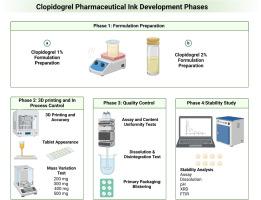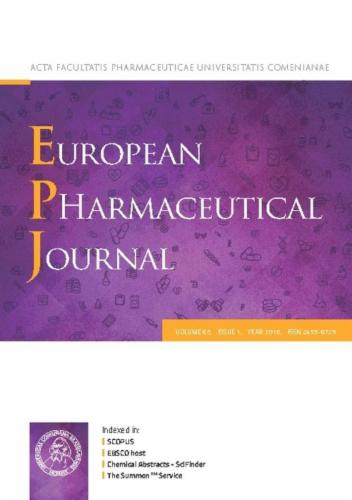基于挤压的自动配药:用于儿科护理的氯吡格雷片剂的个性化剂量和质量控制。
IF 4.3
3区 医学
Q1 PHARMACOLOGY & PHARMACY
引用次数: 0
摘要
三维(3D)打印技术在药物复方制剂中的应用揭示了个性化药物生产的一个前景广阔的前沿领域。这项研究的重点是开发适合儿科使用的硫酸氢氯吡格雷片剂,每片剂量从2毫克到20毫克不等。研究探索了一种基于半固体挤压的沉积技术,该技术已在欧洲多个地区的配制药房中使用。该研究探讨了 1%和 2%氯吡格雷凝胶片剂的各种特性,重点关注质量变化、药物含量均匀性、体外药物释放曲线、崩解时间和稳定性。浓度分别为 1%和 2%的氯吡格雷最小 200 毫克印刷片的平均重量分别为 199.1 ± 4.6 毫克和 201.0 ± 3.2 毫克。最大的 500 毫克印刷片(氯吡格雷浓度分别为 1%和 2%)的平均重量分别为 499.3 ± 7.7 毫克和 501.7 ± 6.5 毫克。1% 氯吡格雷 200 毫克和 500 毫克片剂的平均氯吡格雷含量均匀度分别为 102.0 ± 1.8% 和 96.6 ± 2.6%,2% 氯吡格雷 200 毫克和 500 毫克片剂的平均氯吡格雷含量均匀度分别为 102.6 ± 3.9% 和 101.2 ± 1.6%,均在 3 至 12 的可接受值(AV)范围内。氯吡格雷片剂的 1%和 2%配方都能快速释放药物,达到了美国药典规定的 15 分钟内释放 85% 的目标。浓度为 1%和 2% 的所有规格片剂均符合规定的崩解规格。三个月的稳定性评估显示,两种氯吡格雷制剂的 pH 值和检测结果均符合目标规格(1% 浓度制剂为 93.5%,2% 浓度制剂为 93.6%)。三个月后,X 射线衍射(XRD)和傅立叶变换红外光谱(FTIR)结果表明氯吡格雷片剂具有稳定性。总之,对我们开发的氯吡格雷片剂进行的全面评估表明,采用所介绍的基于半固体挤压的自动化技术,该片剂适用于临时临床使用。本文章由计算机程序翻译,如有差异,请以英文原文为准。

Automated extrusion-based dispensing: Personalized dosing and quality control of clopidogrel tablets for pediatric care
The exploration of three-dimensional (3D) printing inspired technologies in pharmaceutical compounding reveals a promising frontier in personalized medicine manufacture. This study focuses on the development of clopidogrel bisulphate tablets, with doses ranging from 2 mg to 20 mg per tablet, suitable for pediatric use. The study explored a semi-solid extrusion-based deposition technology already being used in compounding pharmacies across several European locations. The investigation explored various properties of two formulations of 1 % and 2 % clopidogrel gel tablets, with a specific focus on mass variation, drug content uniformity, in vitro drug release profiles, disintegration time, and stability.
The mean weights of the smallest printed 200 mg tablets with 1 % and 2 % clopidogrel concentrations were 199.1 ± 4.6 mg and 201.0 ± 3.2 mg, respectively. For the largest printed 500 mg tablets with 1 % and 2 % concentrations, the mean weights were 499.3 ± 7.7 mg and 501.7 ± 6.5 mg, respectively. The mean clopidogrel content uniformity for 1 % clopidogrel 200 mg and 500 mg tablets were 102.0 ± 1.8 %and 96.6 ± 2.6 %, respectively, and for 2 % clopidogrel 200 mg and 500 mg were 102.6 ± 3.9 % and 101.2 ± 1.6 %, respectively, well within the acceptable acceptance value (AV) range of 3 to 12. Both 1 % and 2 % formulations of clopidogrel tablets exhibited rapid drug release, meeting the USP pharmacopeial target of 85 % release in 15 min. All tablet sizes formulated at 1 % and 2 % concentrations met specified disintegration specifications. The stability assessment over three months revealed consistent pH values and assay results within target specifications for both clopidogrel formulations (93.5 % for 1 % formulation and 93.6 % for 2 % formulation). At three months, X-ray Diffraction (XRD) and Fourier Transform Infrared Spectroscopy (FTIR) results demonstrated stability in clopidogrel tablets.
In conclusion, a comprehensive evaluation of our developed clopidogrel tablets demonstrate their suitability for clinical use in an extemporaneous setting using the presented semi-solid extrusion-based automation technology.
求助全文
通过发布文献求助,成功后即可免费获取论文全文。
去求助
来源期刊
CiteScore
9.60
自引率
2.20%
发文量
248
审稿时长
50 days
期刊介绍:
The journal publishes research articles, review articles and scientific commentaries on all aspects of the pharmaceutical sciences with emphasis on conceptual novelty and scientific quality. The Editors welcome articles in this multidisciplinary field, with a focus on topics relevant for drug discovery and development.
More specifically, the Journal publishes reports on medicinal chemistry, pharmacology, drug absorption and metabolism, pharmacokinetics and pharmacodynamics, pharmaceutical and biomedical analysis, drug delivery (including gene delivery), drug targeting, pharmaceutical technology, pharmaceutical biotechnology and clinical drug evaluation. The journal will typically not give priority to manuscripts focusing primarily on organic synthesis, natural products, adaptation of analytical approaches, or discussions pertaining to drug policy making.
Scientific commentaries and review articles are generally by invitation only or by consent of the Editors. Proceedings of scientific meetings may be published as special issues or supplements to the Journal.

 求助内容:
求助内容: 应助结果提醒方式:
应助结果提醒方式:


